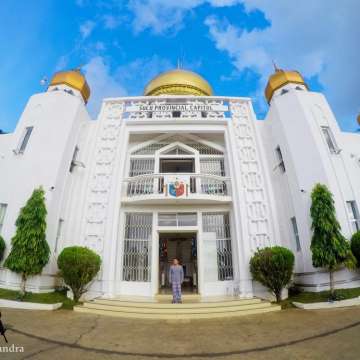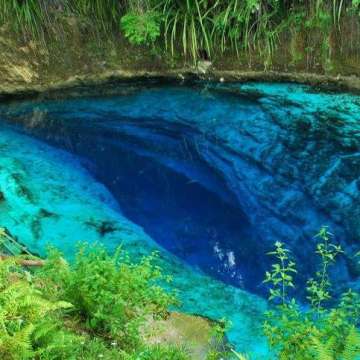About surigao del norte

Surigao del Norte, officially the Province of Surigao del Norte, is a province in the Philippines located in the Caraga region of Mindanao. The province was formerly under the jurisdiction of Region 10 (Northern Mindanao) until 1995. Its capital is Surigao City. The province comprises two major islands—Siargao and Bucas Grande—in the Philippine Sea, plus a small area at the northeastern tip of mainland Mindanao and other surrounding minor islands and islets. This mainland portion borders Agusan del Norte – between the Municipality of Alegria in Surigao del Norte and the Municipality of Kitcharao in Agusan del Norte; and the province of Surigao del Sur, to the south.
Surigao del Norte is the second northernmost of the Mindanao provinces and is an important commerce and transportation hub between Visayas and Mindanao. Numerous ferries cross the Surigao Strait between Surigao and the island of Leyte transporting vehicles, cargoes, and passengers between Liloan in Southern Leyte and Surigao City.
There are two presumptions on the original meaning of "Surigao" among linguists, depending on the original root word. If the root word was taken to be sulig ("sprout" or "spring up"), then Surigao may have derived from suligao ("spring water"), likely referring to the Surigao River (known as "Suligaw" in Mandaya) that empties at the northern tip of the island of Mindanao. Early historical accounts record the name of the river as Suligao, Surigao, or Zurigan.
Another possibility is that it is derived from Visayan "surogao" or "suyogao," meaning "water current". From suyog (also sulog or surog), "current". Other Visayan words derived from the same root include Sinulog, Sulu, and Tausug (Suluk).
History
Rajah Siawi and Rajah Kulambo, members of the nobility of the Surigaonon and Butuanon people, respectively, were encountered by the Magellan expedition in 1521 on the island of Limasawa (which was a hunting ground for the rulers). Antonio Pigafetta describes them as being tattooed and covered in gold ornaments. Pigafetta also records the name of the Surigao region as "Calagan".
The explorer Ruy López de Villalobos headed an expedition to Surigao in 1543, an attempt at subjugation which failed because of the resistance of the natives. At that time the island of Mindanao was given the name Caesarea Caroli, in honor of Carlos V of Spain. Jesuit missionaries visited Butuan in 1597 but did not make much progress in Christianizing the people. It was not until 1609, when a full-dress expedition was launched, that Spanish authority was imposed to Tandag. In 1622, the arrival of the Recollect missionaries in Tandag commenced the establishment of a permanent mission in Surigao.
The area of Surigao del Norte was once part of an ancient district referred to as "Caraga" during the Spanish colonial period named after its chief inhabitants, the Caraga tribe or Caragans who were largely concentrated in a settlement called Caraga. The ancient district of Caraga, which was established in 1609 comprised all of the present day provinces of Surigao del Norte, Dinagat Islands, Surigao del Sur, the northern part of Davao Oriental and eastern Misamis Oriental. The seat of government was at Tandag until it was transferred to the town of Surigao in 1848. Six Spanish military districts were established in Mindanao in 1860 and the areas of present-day Surigao del Norte, Surigao del Sur, Dinagat Islands, Agusan del Norte and Agusan del Sur (collectively called Agusan back then), including the territory lying between present day Butuan and Caraga bays, formed the third district called the "East District" which was changed in 1870 to "Distrito de Surigao". By the end of the Spanish rule in 1897, Agusan had been organized as a single politico-military comandancia named "Butuan", within the administrative jurisdiction of Distrito de Surigao.
On December 23, 1898, the last Spanish Governor of Surigao turned his authority over to a provisional Filipino "Junta Provincial" Peacefully. The Spanish Government along with the Spanish community soon left Surigao by the next day on December 24 leaving behind Spanish missionaries. They were sent off with the sound of music and goodwill by the locals. The Junta Provincial elected Jantoy Gonzalez to serve as the Provisional head while waiting for the arrival of the new authority from Luzon that was sent by Aguinaldo.
First and Official Flag Raising in Mindanao. Father Alberto Masoliver, S.J., during his stint as the parish priest of Surigao in 1898, kept a compilation of his diaries, entitled Diario de la Casa de Surigao. His diaries are currently stored in the Jesuit archives at Centro Borja, Sant Cugat del Valles, Spain. He thus wrote on December 26, 1898, "Before 10:00 AM, the tri-color was hoisted from Casa Real seat of provincial government) and the Tribunal … without any formalities … without anybody's attention being drawn…..these people have no idea of what it is all about, and if they have… how peaceful and without malice they are.". Surigao then was the cabecera and the seat of government of the province of Caraga which had jurisdiction over Surigao, Butuan and Cagayan de Misamis (Cagayan de Oro). Alejandro (Jantoy) Gonzalez was the president of the Junta Provincial of Surigao during the time of the first flag hoisting.
The New Authority under Aguinaldo's Supreme Revolutionary Government arrived in Surigao by January 12, 1899, they were the brothers Simon and Wenceslao Gonzales, children of Jantoy Gonzales.
by March 24, 1899, a new military and political figure appeared in Surigao. Don Prudencio Garcia staged a coup which resulted in the imprisonment of the Gonzalezes (Jantoy, Simon, and Wencaslao), and were killed shortly after in Cortez (now Surigao Del Sur).
Finally, on April 2, 1899, at 12 midnight they were put in a boat, well handcuffed, and shipped out to the Pacific, and upon arriving at Cortes they shot them down. They had been guarded by soldiers and officials who were all personal enemies of the Gonzalezes. In Cortes they were put under the custody of a mestizo, Hilarion Marinez, whom the Gonzalezes had maltreated by words and deeds. He avenged himself by having them fusilated. That was the Tragic end of our enemies ("Apuntes..." p. 116)
The news of what led to the deaths of the Gonzalezes did not reach Aguinaldo as they were given false information to their deaths. Aguinaldo was given a message from an "unknown correspondent" which stated
"General Simon Gonzales and his brother Wencaslao, the Governor of Surigao has been assassinated for collecting excessive contribution in money for the war, and their successors have also been assassinated by the Moros who form a greater part of the population and who have revolted against Filipino rule" (Philippine Insurgent Record 1039.5 in Taylor)
the letter stated that the Gonzales were assassinated, and that the Moros were blamed for the deaths of the predecessors despite having barely any Moros in Surigao by that time.
After the execution of the Gonzalezes, Hermenegildo Narciso (A former ally of Garcia) grabbed the position of Governor. By around July 1899, around 400 men armed against Garcia took position outside the Provincial Capital (Surigao City) with 80 men in the trenches near the exit of the town. On July 8, 1899, Garcia returned to Surigao from Banganga with all the honors befitting as a General. Governor Narciso (who was still in Manila) was expected to return to Surigao to take full control of the Provincial Junta.
July 6, 1899, Soldiers (Garcia) began defending the Government house and Military Quarters in Provincial Capital, and at 6 o'clock Garcia's Soldiers and Narciso's soldiers had a shooting exchange. By 7 o'clock Garcia prepared to leave Surigao via sea. The soldiers of Narciso began their offensive when the boat started loading equipment. They took position behind the Acacia trees, and once they were discovered both sides exchanged fire. Garcia's soldiers retreated to the port and those who were not able to ride the boat with General Garcia were forced to hide and surrender. The area of the conflict is at the present day Surigao Luneta Park and alongside the street of Borromeo. The Province of Surigao would then be engulfed in Military rivalry between Governor Narciso and General Garcia, with Surigao and Butuan held by Narciso while Placer, Cantilan, and Tandag being held by Garcia. This Military Rivalry would be put to a close by the American Occupation of the Province.
Distrito de Surigao became a chartered province on May 15, 1901 (Philippine Commission Act 127). The territorial expanse of the Surigao province was further reduced in 1907 when the politico-military commandancia of Butuan, then a sub-province of Surigao, was created into a separate province and officially named it Agusan with present-day Butuan as its capital.
On September 18, 1960, through Republic Act 2786 dated June 19, 1960, the province of Surigao was divided into the present-day provinces of Surigao del Norte and Surigao del Sur. Agusan province was later dissolved and divided into the present-day provinces of Agusan del Norte (retains present day Butuan as capital) and Agusan del Sur in 1967 by Republic Act No. 4979. The town of Surigao became a city on August 30, 1970, pursuant to RA 6134.
Dinagat Islands had been a part of the First District of Surigao del Norte until becoming a province on its own on December 2, 2006, with the approval of Republic Act No. 9355, the Charter of the Province of Dinagat Islands, in a plebiscite. Between February 2010 and March 2011, the islands were part again of Surigao del Norte after declaring RA 9355 unconstitutional by the Supreme Court, then were reinstated as a separate province.
More Provinces


surigao del sur
Surigao del Sur is a province in the Philippines located in the Caraga region in Mindanao. Its capital is Tandag City. Surigao del Sur is situated at the northeastern coast of Mindanao facing the Pacific Ocean. It is approximately 300 kilometers in length and 50 kilometers at its widest stretch. ...read more

